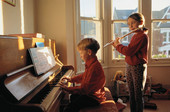
FRIDAY, Nov. 16 (HealthDay News) — The child Mozarts of the world may have some traits in common with children with autism, a new study suggests, in findings researchers say could eventually offer clues into the developmental disorder.
It’s estimated that about one in 88 children has an autism spectrum disorder, an umbrella term for a group of developmental brain disorders that hinder a person’s ability to communicate and interact with others. These range from the severe cases of “classic” autism to a relatively mild form called Asperger’s syndrome.
Child prodigies — those kids with exceptional, beyond-their-years talent in areas like music, art or math — are much more rare.
No one is sure of the exact figures, but a good guess would be about one in 5 million is a prodigy, said Joanne Ruthsatz, an assistant professor of psychology at Ohio State University and lead author of a study published in the September-October issue of Intelligence.
In theory, there could be a connection between kids with autism and child prodigies. There are, after all, autistic “savants,” who have some type of remarkable skill — often in math or art — despite their developmental disability.
To study the question, Ruthsatz and colleague Jourdan Urbach of Yale University tracked down eight child prodigies — including two musicians who were playing Carnegie Hall around kindergarten age, and another who was programming computers by age 3 and reproducing complicated musical pieces at age 4.
Each prodigy, two of whom are now adults, took a standard test of traits associated with autism.
The prodigies scored higher-than-normal on the autism trait “attention to detail” and outscored a comparison group composed of 58 people with Asperger’s or “high-functioning” autism with normal-range IQs.
“It’s that attention to detail that really underlies their talent,” Ruthsatz said. “They don’t miss anything.”
In a separate battery of tests, looking at overall intelligence, the prodigies also scored exceedingly high in “working memory” — the brain’s ability to juggle several pieces of information at a time, in order to get a task done.
But what was most striking, Ruthsatz said, was the prodigies’ family and personal histories: Four had a first- or second-degree relative with an autism spectrum disorder, and three had themselves been diagnosed with an autism spectrum disorder in the past.
“Our findings suggest that child prodigies have traits in common with autistic children, but that something is preventing them from having the deficits associated with autism,” Ruthsatz said.
“I think child prodigies may have a genetic modifier that allows them to display the talent without the deficits,” she explained.
Ruthsatz acknowledged, however, that this is all speculation for now.
Her team has collected DNA samples from their prodigy group, which now totals 16. They hope to be able to hunt for gene variants that could explain their findings.
Ruthsatz said that could ultimately pave the way for a better understanding of autism, and possibly new drug therapies.
An autism expert not involved in the study was more cautious, though.
The findings are “very interesting,” said Dr. Andrew Adesman, chief of developmental and behavioral pediatrics at Steven & Alexandra Cohen Children’s Medical Center of New York, in New Hyde Park.
“Of course, we’ve long known that there are some autistic individuals with extraordinary abilities, and there are people with extraordinary talents who are not autistic,” Adesman said.
But both groups are unusual, he noted. “I don’t think research on child prodigies is the most fruitful way for furthering our understanding of, and treatment of, autism,” Adesman said.
That doesn’t mean the questions are not worthwhile, he added. “You never know where the next research breakthrough will come from,” Adesman noted. “That said, I think the bulk of the research should be on kids with more typical presentations (of autism).”
More information
Learn more about autism from the U.S. National Institute of Child Health & Human Development.

